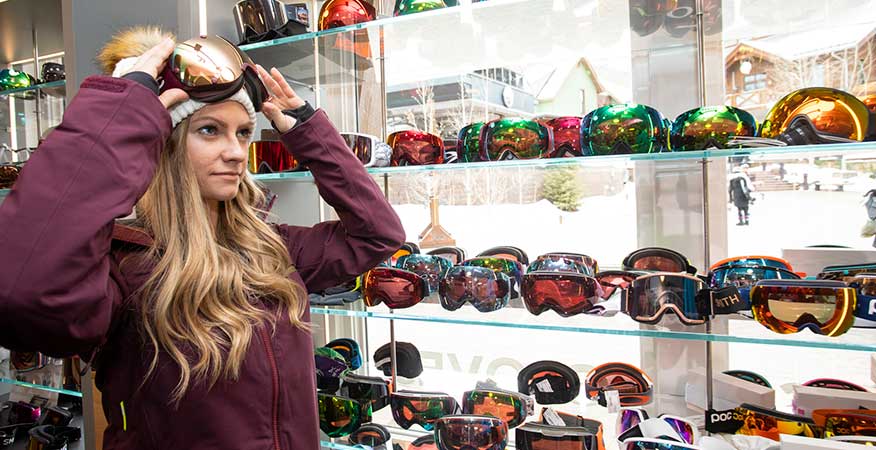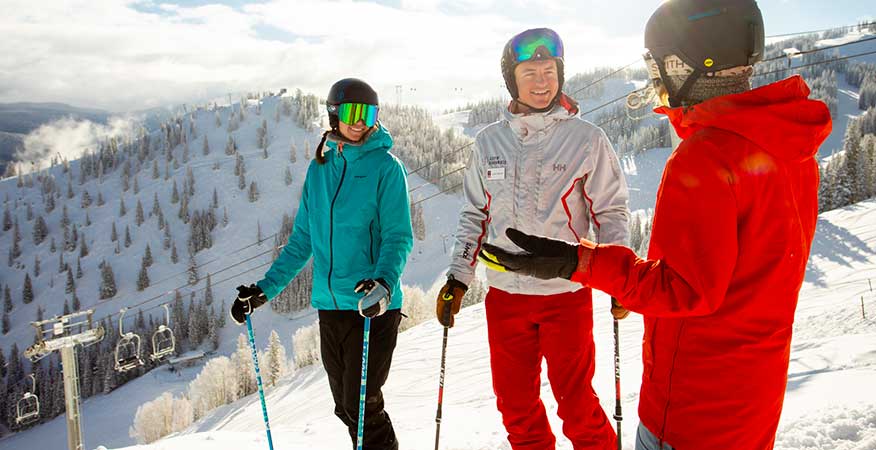
Beginner's Guide to Skiing & Snowboarding

Colorado is lucky to have over 300 days of sunshine a year, so be sure to apply sunscreen before you head out on bluebird days.
Gear and Getting Ready

Group of skiers descend a slope
Getting the right gear and properly preparing for your day on the slopes can make all the difference, especially for beginners. From choosing comfortable, well-fitting equipment to dressing in layers designed for mountain weather, having the right essentials ensures both safety and enjoyment. Understanding the day ahead—like checking the forecast and knowing the terrain conditions—helps you plan what to wear and pack, so you’re ready for anything the mountain throws your way. Whether you're renting or buying, knowing what to look for in skis, snowboards, boots, and clothing can save you from unnecessary discomfort and help you focus on mastering the basics. With a little preparation, you'll set the stage for a smooth and memorable first day on the mountain.
What is a Bluebird Day?
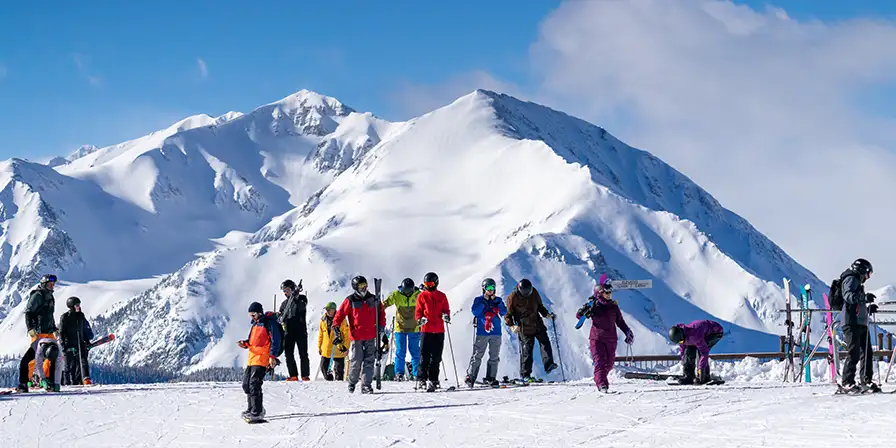
Conditions
Chilly, but crystal clear blue skies and bright sunshine
The Gear
Base layers – Leggings or long underwear on bottom (think yoga pants or similar), cold-weather long sleeve sweat-wicking athletic top on top
Mid layer – Fleece jacket or a lightweight puffy
Top layer – Waterproof snow jacket, waterproof ski pants
Accessories – Goggles for high light; gloves; glove liners; lip balm in pocket; sunscreen; sunglasses in pocket for après; and, for the 2020-21 season, a face mask for gondolas, lifts and other areas on the mountain.
What is a Powder Day?
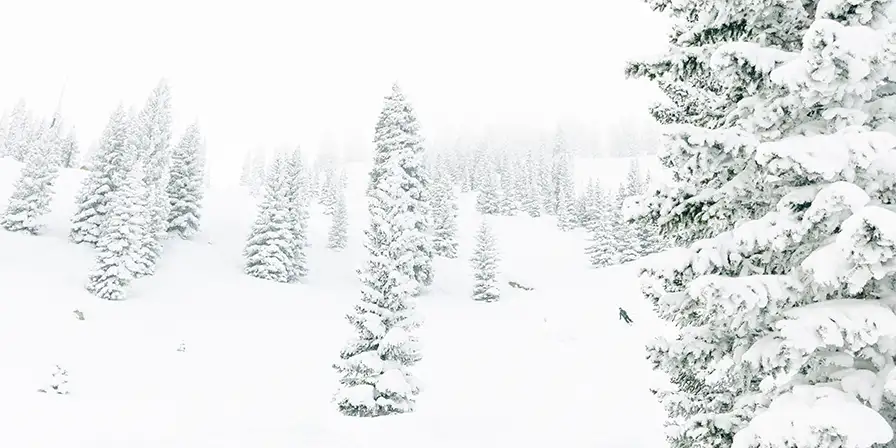
The Conditions
Cloudy and snowing consistently throughout the day.
The Gear
Base layers – Leggings or long underwear on bottom (think yoga pants or similar), cold-weather long sleeve sweat-wicking athletic top on top
Mid layer – Fleece jacket or light down jacket
Top layer – Waterproof snow jacket, waterproof ski pants
Accessories – Goggles for low-light; neck gaiter/buff; gloves; glove liners; lip balm in pocket; hand warmers in pocket and, for the 2020-21 season, a face mask for gondolas, lifts and other areas on the mountain.
What is a Spring Day?
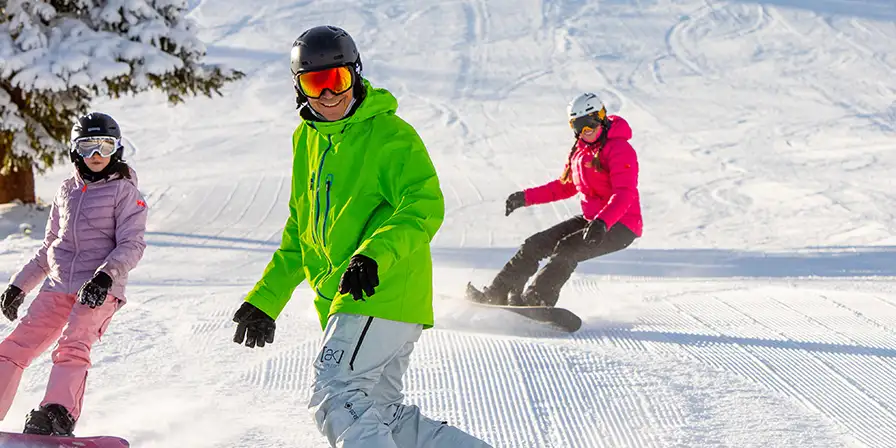
The Conditions
Warm and sunny, with the chance of cold winds and occasional bursts of snow.
The Gear
Base layers – Warm-weather sweat-wicking athletic top on top; base-layer pants are optional since your waterproof ski pants may keep you warm
Mid layer – Not necessary
Top layer – Lighter, waterproof top layer; waterproof ski pants
Accessories – Goggles for high light; gloves; lip balm in pocket; sunscreen; sunglasses in pocket for après and, for the 2020-21 season, a face mask for gondolas, lifts and other areas on the mountain.
What gear should I get?
Our friends at Four Mountain Sports can hook you up with all of it, and our friends at the Ski & Snowboard School can show you how to use it!
What else should I bring?
When Should I Visit?

Skier riding out a groomer on a bluebird day at Snowmass
November
December
Moving into December, conditions typically improve allowing more and more terrain to open, expanding your opportunities for adventure. Aspen Highlands and Buttermilk typically open in early December. Early December is also a great time to take advantage of packages and deals to get the most bang for your buck. Then, in late December, the towns of Aspen and Snowmass light up as we approach the holidays. The holidays are a magical time here and are our busiest time of year for good reason!
January
In January, snow conditions start to peak and you’ll have runs all to yourself since the holiday crowds have left. This month is the perfect time for a romantic getaway or luxurious winter escape. Normally, Gay Ski Week happens during mid-January, providing many opportunities to celebrate as well.
February
March
April
Preparing for the Mountains

Snowmass mountain as a winter storm lifts
The good news is that our bodies eventually adjust to elevations over the course of a few days, but everybody is different. Learn more about altitude sickness from the Cleveland Clinic.
Altitude
The higher you go in elevation, the less oxygen there is to breathe, which means your body has to work harder to get the oxygen it needs to function. Symptoms of altitude sickness include headaches, nausea, loss of appetite and difficulty sleeping. Mild fatigue is normal, but if symptoms increase, your only remedy is to go to a lower elevation and you should seek medical help if the symptoms are severe. In order to avoid altitude sickness, you should do the following:
- Acclimate: Take it easy on your first day at Aspen Snowmass and allow your body to adjust to the altitude before you enjoy a night out or a big day on the slopes.
- Drink water: And we mean A LOT of water.
- Rest: Allow your body time to catch up to you and replenish your oxygen stores.
- Get low: If you do start to feel altitude sickness coming on, return to lower elevation at the base of the mountain and call it a day.
Sunscreen
Higher elevation means higher risk for sunburn, even in winter. Colorado is lucky to have over 300 days of sunshine a year, so be sure to apply sunscreen before you head out on bluebird days.Stop by to see one of our ambassadors around the mountain and grab some free Supergoop sunscreen (and maybe some apple cider to hydrate too).
Alcohol
Be aware that alcohol WILL hit you harder while you’re at altitude. You should plan to take it a little easy at après and drink slightly less than you otherwise would at home until you get your bearings. You’ll thank yourself later! In addition, make sure you are staying hydrated and drink water throughout the day and night. The mountains are a lot drier and you'll find yourself dehydrated quicker than at home. With alcohol in the mix this problem can be compounded even more, so make a conscious effort to sneak water in on all your ski breaks.Types of Snow Conditions
Types of Snow Conditions

Snowboarder carving a turn in fresh powder
Bluebird Day
Corduroy / Groomed
Corn Snow
Crust
Dump
Frozen Granular
Hardpack
Packed Powder
Powder
Wind Packed
White Out
Ski & Snowboard Vocabulary

Friendly skiers waving hello on the slopes
